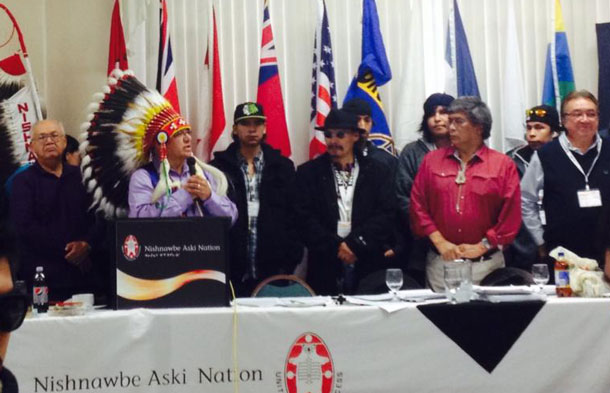

THUNDER BAY – OP-ED – Canada’s Assembly of First Nations (AFN) descended upon Halifax for its 25th annual meeting, and one of the most contentious issues on the table was First Nations education reform. Chiefs representing half of the 630 First Nations across Canada were there, in large measure, to decide on the next move after rejecting the Harper government’s Bill C-33, aimed at completely revamping on-reserve education.
The legislation and associated $1.9-billion multi-year financial deal, endorsed by former AFN National Chief Shawn Atleo, sparked widespread dissent, eventually leading to Atleo’s demise. Overriding the AFN education committee, chaired by Mi’kmaq Morley Googoo of Waycobah First Nation, the vast majority of chiefs and band representatives, particularly in Ontario, Quebec, and the Prairie West, rejected it as a sham imposed upon them by Aboriginal Affairs Minister Bernard Valcourt with a patina of consultation.
Finding a consensus at the Halifax AFN assembly was not easy, given the residue of broken trust not only with the Conservative government, but also within the AFN itself. The two initial proposed education resolutions were crystal clear in their rejection of Bill C-33. In addition, Morley Googoo was away for the debate recovering from recent surgery.
Gilbert Whiteduck, of the Quebec Algonquin Nation, Kitigan Zibi Anishinabeg, was outspoken in his criticism of the proposed deal. “We’re being told, by the minister, that he’s not pouring money into an old school bus,” he declared. “But, hold on, because he wasn’t putting money into the bus in the first place.” The real answer, according to Whiteduck, is to “build upon existing First Nations schools” not to impose another layer of federal bureaucracy.
Moderates like Jaime Battiste, interim regional chief for Nova Scotia and Newfoundland, sounded more conciliatory. “I heard a lot of chiefs saying that they don’t want to throw the baby out with the bath water, that there’s room for discussion,” he told Canadian Press.
The chiefs proved to be in no mood to compromise. Proposed education reform resolutions from Chief Ava Hill, Six Nations of Grand River, Ont., and Debra Foxcroft, Tseshaht First Nation, B.C., both reaffirmed a May 27 resolution rejecting the bill outright and calling for “an honourable process” leading to a plan respecting “regional and local diversity” and “inherent treaty rights.”
The special assembly organizers worked overtime, behind the scenes, to paper over any cracks on the First Nations front. Two competing resolutions were consolidated, and appeared miraculously, on July 17, with Hill and Foxcroft as movers and seconders. There would be no repeat of the unceremonious dumping of the AFN-Ottawa deal leading to Atleo’s departure.
The compromise resolution sailed through because it moved past the rejection of Bill C-33 to propose a few new preconditions for renegotiating the education settlement. In the wake of the shelved federal bill, the AFN is now committed to the advancement of First Nations education in a manner that: 1. fully respects regional and local diversity; 2. protects and strengthens existing regional initiatives; 3. properly resources regional education systems, respecting cultural and language traditions and providing “appropriate and agreed upon accountability” for financial and educational results.
Two new wrinkles have been added to the AFN education reform agenda. Chiefs will now be more insistent upon the need to “respect partnership” and be “consistent with treaty relationships.” They are also seeking a firmer commitment to “transition out from under the Indian Act.”
How the AFN proposes to get there is still murky. Instead of proceeding to propose a “facilitation committee” to nail down the “funding framework,” the gathering opted to take more time to develop a process aimed at putting the desired pieces together out of the shattered AFN-Ottawa accord.
Even though the AFN met in Halifax, in Mi’kmaw territory, there was little or no open discussion about the governance models provided by regional initiatives like the Mi’kmaw Kina’matnewey (MK). That’s the uniquely Nova Scotian Mi’kmaw school authority funded by the Department of Aboriginal Affairs and Northern Development six years ago, originally to oversee a single First Nations school in Shubenacadie First Nation.
Today, the MK operates 12 schools with some 3,000 students in 13 different Mi’kmaw communities and shows some promise for improving student achievement, especially the high school completion rates, and the life chances of its graduates. So the fundamental question arises: how can First Nations-run community schools like the MK be built more effectively into the current education reform process?
Beating back the recent federal bureaucratic intrusion is still absorbing far too much of the policy-making energy. Yet the Halifax AFN meeting sent out the right signals. “Each region, each nation,” as Battiste of Eskasoni recently noted, “has their own people that they would rather have working on (education reform) than a bigger bureaucracy out of Ottawa.”
Paul W. Bennett.
Paul W. Bennett is senior education fellow at the Northern Policy Institute. His next report, co-authored with the University of Alberta’s Jonathan Anuik, will address First Nations education renewal. For more information visit The Northern Policy Institute












